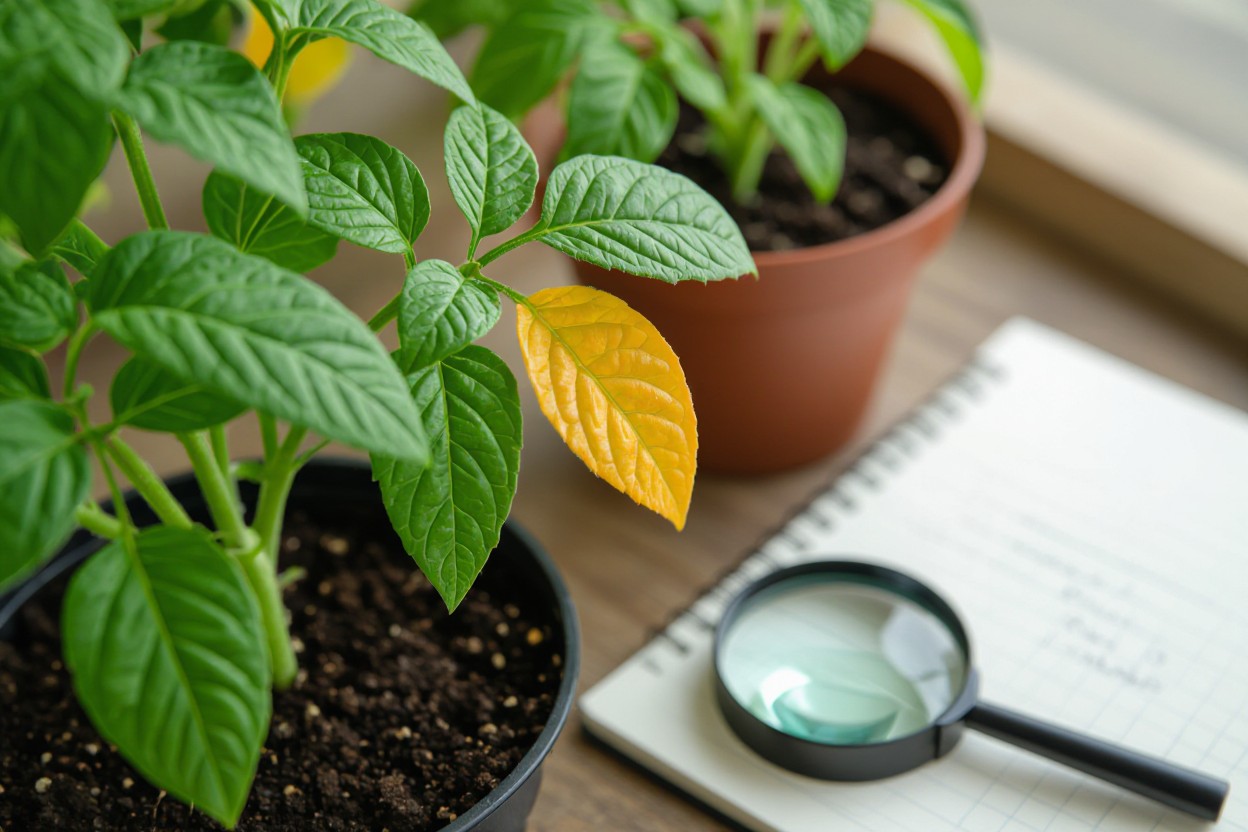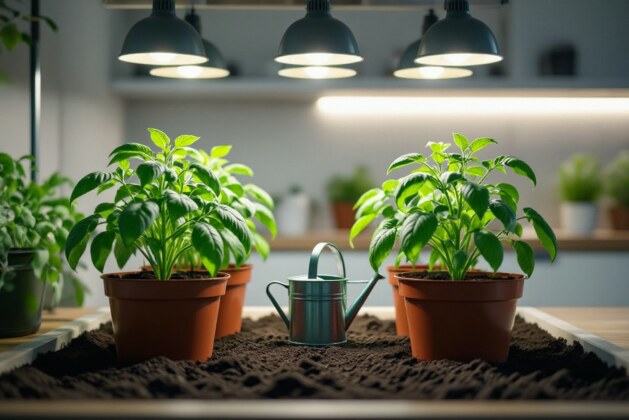Indoor gardening offers a fantastic way to enjoy fresh, homegrown tomatoes all year round, especially when outdoor space is limited. In this guide, I’ll show you how to create the perfect environment for your tomato plants to thrive inside your home. You’ll learn about choosing the right containers, providing sufficient light, and managing watering techniques to prevent issues like root rot. By following these proven steps, you can turn your urban space into a productive tomato haven that delivers delicious fruits safely and efficiently.
Crafting the Perfect Indoor Environment
Creating the ideal indoor environment for your tomato plants involves balancing light, temperature, and humidity to mimic their natural growing conditions. Tomatoes flourish with plenty of light and steady warmth, while excessive dryness or chill can stunt growth. Adjusting these elements within your urban space ensures your tomatoes not only survive but thrive, bringing juicy harvests straight from your window sill.
Selecting the Right Light Source
Tomatoes demand a minimum of 12-16 hours of bright light daily to grow robustly. I recommend full-spectrum LED grow lights, which provide the same light wavelengths plants use for photosynthesis, while being energy efficient and producing less heat compared to traditional bulbs. Position the light about 12-18 inches above the plants and adjust as they grow to prevent leaf burn or stretching.
Temperature and Humidity Considerations
Maintaining daytime temperatures between 70-75°F and nighttime lows around 60-65°F supports optimal tomato growth. Relative humidity should hover around 50-70% to prevent stress and minimize disease risk. Using a small room humidifier or a pebble tray with water can help raise humidity in dry indoor conditions, while adequate ventilation prevents mold and mildew buildup.
Temperature and Humidity Guidelines for Indoor Tomatoes
| Factor | Ideal Range |
|---|---|
| Daytime Temperature | 70-75°F (21-24°C) |
| Nighttime Temperature | 60-65°F (16-18°C) |
| Relative Humidity | 50-70% |
Temperature fluctuations beyond this range can lead to flower drop or poor fruit set, while humidity levels below 40% increase the risk of spider mites and other pests. Conversely, excessively high humidity over 80% invites fungal diseases like powdery mildew. Keeping these factors balanced through consistent monitoring and simple devices keeps your tomato plants vigorous and productive.
Choosing the Best Tomato Varieties for Indoor Growth
Picking the right tomato varieties makes a significant difference in indoor gardening success. Compact plants with determinate or semi-determinate growth habits generally perform best indoors due to limited space. Varieties bred specifically for container gardening, such as cherry or patio tomatoes, tend to produce consistent yields and require less upkeep. Assume that choosing varieties with known disease resistance and manageable plant size will keep your indoor garden thriving and productive.
Determining Suitable Tomato Types
Selecting the right types means focusing on determinate, indeterminate, and semi-determinate tomatoes. Determinate types grow to a fixed size, making them ideal for containers but often yield all at once. Indeterminate varieties grow continuously and bear fruit throughout the season but need more vertical space and pruning. Semi-determinate offers a balance between the two. Here’s a quick rundown of traits to consider:
| Tomato Type | Indoor Growth Trait |
|---|---|
| Determinate | Compact, limited height, early fruit |
| Indeterminate | Tall, continual growth, long harvest |
| Semi-Determinate | Moderate size, extended harvest window |
| Cherry Tomatoes | Small fruits, prolific yield, space-efficient |
| Patio Tomatoes | Compact plants, bred for containers |
- Cherry tomatoes maximize fruit count and fit snugly on windowsills.
- Patio varieties are bred for confined environments.
- Determinate types reduce maintenance but limit harvest timing.
- Indeterminate need staking or cages indoors.
Understanding Growth Habits and Yield Potential
Growth habit impacts how and where you place your plants indoors. Determinate tomatoes generally reach 3-4 feet and produce fruit all at once in 6-8 weeks. In contrast, indeterminate plants climb up to 6 feet or more, supplying tomatoes over months but requiring regular support and pruning. Assume that matching plant habit to your available space and daily care capacity ensures steady, manageable yields.
Yield potential links closely to growth habits and variety choice; cherry tomatoes often produce over 100 fruits per plant, while larger slicer varieties yield fewer but substantial tomatoes. Indoor gardeners benefit by selecting varieties optimized for controlled environments and container limitations, adjusting expectations toward more frequent but moderate harvests throughout the growing period.
Soil and Container: Setting Up for Success
The foundation of thriving indoor tomato plants lies in choosing the right soil mix and container. I opt for well-draining, nutrient-rich potting soil designed for vegetables, ensuring it holds moisture without becoming waterlogged. The container must offer adequate space for root expansion, with drainage holes to prevent root rot. This combination supports robust root systems and sustained growth, helping your tomatoes flourish even in confined indoor settings.
Optimal Soil Composition for Indoor Tomatoes
Indoor tomato plants benefit from a soil blend that’s both light and fertile. I prefer a mix combining peat moss, vermiculite, and composted organic matter, which offers excellent aeration and moisture retention. A slightly acidic to neutral pH of 6.0 to 6.8 encourages nutrient uptake. Avoid heavy garden soils that compact easily; they inhibit root growth and drainage. Supplementing with slow-release fertilizer or liquid feeds approximately every two weeks boosts your plant’s vitality and fruit production.
Picking Containers that Promote Healthy Growth
Choosing a container with at least 12 inches in diameter and depth provides ample room for tomato roots, promoting vigorous growth. Clay pots allow breathability but dry out faster, while plastic containers retain moisture longer. Containers should have multiple drainage holes to prevent excess water accumulation, crucial for avoiding root diseases. I also suggest selecting containers with sturdy bases to support heavy, fruit-laden plants, and consider self-watering pots for consistent moisture levels.
Diving deeper into choosing the right container, consider the tomato variety—determinate types often thrive in smaller pots, while indeterminate ones demand larger, deeper containers to accommodate sprawling roots. For urban gardeners with limited light, white or light-colored pots reflect sunlight, preventing overheating. Additionally, using containers with built-in reservoirs can maintain steady soil moisture, minimizing stress from irregular watering. These smart choices help sustain healthy root environments, ensuring your tomatoes can develop their full flavor and yield potential indoors.
Mastering Nutrients and Watering Techniques
As your indoor tomato plants begin to flourish, managing their nutrient intake and watering schedule becomes increasingly vital. I’ve found that understanding the specific needs for macro and micronutrients alongside precise watering routines can significantly boost growth and fruit yield. Overfeeding or inconsistent watering often leads to leaf burn or root rot, so it’s worth honing these techniques carefully to maintain robust, healthy plants all season long.
Essential Nutrients for Indoor Tomato Plants
Tomatoes thrive on a balanced supply of nitrogen, phosphorus, and potassium, often supplied in a 5-10-10 fertilizer formula for fruiting. Nitrogen supports lush, green foliage, but excessive amounts can reduce fruit production, so moderation is key. Magnesium and calcium deficiencies are common indoors—calcium prevents blossom-end rot, a frequent issue in container-grown tomatoes. Using a comprehensive fertilizer or supplementing calcium and magnesium can help maintain healthy development and enhance the flavor of your homegrown tomatoes.
Watering Strategies to Prevent Over or Underwatering
Consistent moisture without waterlogging the roots is the sweet spot for indoor tomatoes. I use moisture meters and check soil dampness before watering to avoid overwatering, which can suffocate roots and invite fungal diseases. On the other hand, allowing the top inch of soil to dry out signals the right moment to water, preventing underhydration that stresses the plant and reduces yield. Setting a routine but tailoring it based on environment and plant needs minimizes common watering errors.
Monitoring soil moisture levels through tactile checks and tools like a hygrometer helps adjust watering frequency precisely, especially since indoor conditions can vary drastically. I also apply water slowly at the base to encourage deep root growth, reducing surface evaporation. Employing self-watering containers or drip irrigation systems further stabilizes moisture, supporting vigorous plant health and making daily care more manageable in urban settings.

Troubleshooting Common Indoor Tomato Problems
Even in controlled indoor settings, tomato plants face challenges like yellowing leaves, stunted growth, or spots. Spotting these early signs allows you to adjust care quickly, whether it’s tweaking humidity levels or adjusting fertilizer types. For instance, leaf curling often signals water stress, while pale leaves may indicate insufficient nitrogen. Addressing these problems early improves fruit quality and prevents larger issues from developing, keeping your indoor garden thriving.
Identifying Pests and Diseases
Indoor tomatoes aren’t immune to pests like aphids, spider mites, or whiteflies, which can hide under leaves and stunt growth. Diseases such as powdery mildew or blight also pose threats, identifiable by white powdery spots or dark lesions on leaves. Regularly inspect your plants thoroughly, especially the undersides of foliage, and use magnification if needed. Catching infestations early lets you implement targeted treatments, like neem oil or insecticidal soaps, before they severely compromise the plant’s health.
Solutions for Nutrient Deficiencies and Environmental Stress
Nutrient imbalances typically show up in leaf discoloration—yellowing from nitrogen deficiency or purple tints from phosphorus lack. Environmental factors like inconsistent temperatures or insufficient light worsen these symptoms. I often adjust feeding schedules with balanced fertilizers rich in potassium and magnesium and tweak room temperature between 65-75°F to mitigate stress. Employing grow lights ensures tomatoes receive at least 12-16 hours of light daily, promoting healthy photosynthesis and nutrient uptake necessary for robust growth.
Delving deeper, correcting nutrient deficiencies requires knowing which elements are lacking: nitrogen boosts leafy growth, phosphorus supports root and flower development, and potassium enhances fruit maturity. Conducting simple soil or substrate tests guides precise supplementation. Environmental stress can be minimized by stabilizing temperature fluctuations and increasing airflow to reduce humidity-related fungal issues. Integrating slow-release fertilizers with periodic liquid feeds maintains constant nutrient availability, while LED grow lights with adjustable spectra simulate natural sunlight, encouraging vigorous photosynthesis during shorter indoor days.
Final Words
On the whole, growing tomatoes indoors is a rewarding venture that brings the joy of fresh produce right into your living space. I encourage you to carefully select the right varieties and provide sufficient light and care to ensure success. With patience and attention to your plants’ needs, you can enjoy thriving tomatoes year-round. By embracing indoor gardening, you not only enhance your cooking but also develop a deeper connection to nature, even in an urban environment. I’m confident that with your dedication, you’ll find growing tomatoes indoors both fulfilling and enjoyable.





Leave a comment